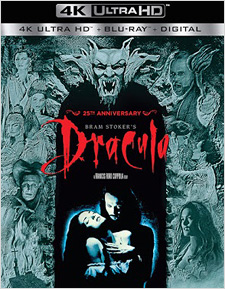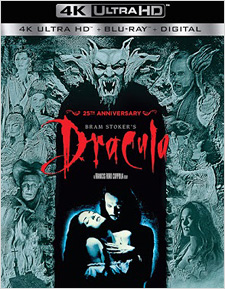Bram Stoker’s Dracula (4K UHD Review)

Director
Francis Ford CoppolaRelease Date(s)
1992 (October 3, 2017)Studio(s)
American Zoetrope/Columbia Pictures (Sony Pictures Home Entertainment)- Film/Program Grade: A
- Video Grade: A
- Audio Grade: A-
- Extras Grade: A-
Review
In 1992, Francis Ford Coppola delivered a surprising big screen version of Dracula, a film that’s at once campy and creepy, an exquisitely crafted powerhouse of theatrical staging and practical production design, matched with performances both thrilling and stupefying. Bits reviewer Greg Suarez had this to say bout the film in his review of Sony’s 2002 Superbit DVD release…
“It would be nearly impossible to list all of the different theatrical derivations Bram Stoker’s 1897 novel Dracula has inspired since the dawn of cinema. The novel has been adapted to different times in history, with certain poetic licenses taken, in many cases, to place the story in less traditional plot situations. Director Francis Ford Coppola’s 1992 telling of Bram Stoker’s Dracula remains a favorite, for its extravagant and richly-textured style and unique spin on the story of Vlad the Impaler.
Bram Stoker’s Dracula tells the tale of 14th Century prince Vlad Dracula (Gary Oldman). Dracula lost his true love to the deception of his enemies and denounced the church, which doomed him to everlasting life as one of the undead, forced to feed off of the blood of man to sustain existence. Several centuries later, London real estate agent Jonathan Harker (Keanu Reeves) calls on Dracula to finalize a deal to purchase Carfax Abbey in London. While he entertains his new guest, Dracula sees a picture of Harker’s fiancée, Mina (Winona Ryder). She looks exactly like Dracula’s long-dead true love, and the Count decides it is his fate to travel to London to reunite with his past, and once again discover true love.
Once in London, Dracula brings with him a plague of death that leaves the city shaken. Little by little, Dracula begins to charm his way into Mina’s heart, while Dr. Van Helsing (Anthony Hopkins) discovers that Dracula is responsible for the evil that has been unleashed on the town. Van Helsing and Harker must save Mina before she becomes Dracula’s bride, doomed to the same tortuous, everlasting existence.
Bram Stoker’s Dracula stands apart from other vampire films in that, in this version, Dracula is not a soulless animal that exists to merely terrorize women and drink blood. Here, Dracula is a terribly lonely man doomed to an eternity of pain and heartache caused by the death of his true love. What Coppola does with this version is give Dracula a reason for existence and more of a history. The audience is actually shown why Dracula is a tortured undead creature, and the plot element of his anguish and loneliness (caused by his lost love) bestows on the character a more human quality. The fact that Stoker’s story has always contained an element of eroticism and sexuality lends itself perfectly to Coppola’s retelling, with the added amount of passion and romantic desire. This film is first a romance, and only second a horror flick.
Coppola’s film is also a marvel of old-school filmmaking magic, from its production design, to its cinematography, and even its practical visual effects. The film’s sets have a big open sense of spaciousness that allows the characters and the detail of their flamboyant costumes to really pop off the screen. The use of shadows and space in the lighting and cinematography also lends an air of mystery to the proceedings. Best of all, Coppola and his son Roman (who served as VFX director) employed strictly in-camera special effects techniques dating back to the dawn of cinema (and directors like Georges Méliès) to give the film a highly unique and effective look. In fact, Bram Stoker’s Dracula was one of the last major Hollywood films to use these techniques before digital effects took over.”
This film has been released many times on disc since its initial theatrical release, most recently in Sony’s Supreme Cinema Series Blu-ray (reviewed here). The studio’s new 4K Ultra HD release was mastered from the same 4K scan of the 35 mm negative, using the same slightly adjusted framing, with the addition of a new HDR10 color grade. The native 4K image is presented in its original 1.85:1 theatrical aspect ratio, and it’s simply exquisite. Allowing for the fact that moderate but appropriate grain is present throughout, and that the occasional shot appears optically soft, this presentation is certainly the ultimate image experience of this film in every way. Detail, especially fine detail, is impressive, rendering a realism to the texture of fabrics, wood, lace, and stone. Blacks are truly dark without feeling crushed, the highlights shine brightly, and the HDR is simply extraordinary. Mina’s satin dress is truly luminous. Dracula’s deep red robes have a subtle sheen accented by shimmering gold embroidery. When Harker is sitting in his firm’s office getting his assignment, the mahogany looks rich, and the room’s leather, brass, and gold appointments gleam. In almost every scene, there are surprising details that draw the eye. The color is lush and vibrant. For fans of this film, it’s just a thrilling image.
The 4K disc’s primary audio is the same English Dolby Atmos mix (7.1 Dolby TrueHD compatible) that was newly created for the Cinema Series BD. The mix has a smoother quality to it than past audio presentations of this film, with greater dynamic range, and richer bass. Sounds tend to linger and decay a little more spaciously, thus enhancing the visuals. The height channels help to enclose the sound field and add greater dimension. Dialogue is clear, panning and movement are nuanced and theatrical, and the Wojciech Kilar score is full and ominous, with rich, organic sounding strings and percussive piano chords. The disc also offers 5.1 Dolby Digital mixes in Czech, French, German, Hungarian, Italian, Japanese, Polish, Portuguese, Russian, Castilian Spanish, and Latin Spanish, with optional subtitles that include English, English SDH, Arabic, Bulgarian, Traditional Chinese, Czech, Danish, Dutch, Finnish, French, German, Greek, Hebrew, Hungarian, Icelandic, Italian, Japanese, Korean, Norwegian, Polish, Brazilian Portuguese, Portuguese, Romanian, Castilian Spanish, Latin Spanish, Swedish, Thai, and Turkish. Quite a lot in other words.
There are no features on the 4K Ultra HD disc, but the package includes the exact same Supreme Cinema Series Blu-ray as before, including the film in 1080p HD (mastered from the same 4K source) with audio commentary by director Francis Ford Coppola, visual effects director Roman Coppola, and makeup supervisor Greg Cannom (carried over from the laserdisc release in 1993), as well as a second and much newer commentary by the director alone. It adds the following video-based extras (in full HD):
- Francis Ford Coppola Introduction (3:55)
- Reflections in Blood: Francis Ford Coppola and Bram Stoker’s Dracula (29:11)
- Practical Magicians: A Collaboration Between Father and Son (20:07)
- The Blood Is the Life: The Making of Bram Stoker’s Dracula (27:48)
- The Costumes Are the Sets: The Design of Eiko Ishioka (14:02)
- In Camera: Naïve Visual Effects (18:46)
- Method and Madness: Visualizing Dracula (12:06)
- Deleted & Extended Scenes (12 scenes – 28:14 in all)
- “Beware” Trailer (1:31)
- Theatrical Trailer (2:36)
It’s an outstanding batch of material. The only thing you’re missing from the Cinema Series release is the booklet with production notes and artwork. The 4K package does also include a paper insert with a Digital Copy code.
Bram Stoker’s Dracula has always been a highly cinematic experience, but it’s never been quite so visceral and engrossing an experience as it is here. If you’re a fan of this film, and have make the leap to 4K, you simply must purchase this Ultra HD release as soon as it becomes available. It’s a revelation.
- Bill Hunt (with Greg Suarez)
(You can follow Bill on social media at these links: Twitter and Facebook)

